
by Osprey Photo Workshops & Tours | Feb 12, 2024 | Flower Photography, Flowers, Garden Photography, Longwood Gardens, Nature Photography, Photo Technique, Photo Workshops, Uncategorized

Light & Flowers
The first image captures the center of the pink lotus flower beautifully lit by soft diffused light. As opposed to bright sunlight, soft light preserves the individual pastel colors of the flower.
Side light when it creates light shadows and tonal gradient on the petals defines the shape of the flower making it appear three dimensional as with the second lotus blossom.
Back light coming from behind the subject and passing through petals and other flower parts can be dramatic and reveal details not easily apparent otherwise like the fuzz on the sepals of the lady slipper. The shadowed background made this detail more apparent. However, the pink part of the lady slipper was shaded. To improve the image, I used a white card to reflect light into the shadows.
Like all photography patience is required. I searched for a perfect Bird of Paradise flower to photograph but had difficulties finding one that did not fade into the background. Finally I found what I was looking for, an individual flower that was backlit with the orange color portion of the flower glowing against a dark background.
The last flower in this series, was lit by the setting sun from behind. It seemed to glow with a beautiful transition of colors from red to yellow.





Problem Background & Solutions
When the background is extremely distracting, consider selecting an angle of view where it is in shadow like the image above.
With some problem backgrounds I have resorted to using an artificial one behind the subject as with this Himalayan Blue Poppy.
One way to create such a background is to I select a scene outside, set the camera to a low F-stop for a shallow depth of field and defocus the lens before taking the photo. Then I print the image, mount it on a stiff background and hold it behind the subject. Another option is to select an image that you already have in your photo files and use Adobe’s Photoshops blur filter and possibly other adjustments to create a suitable backdrop.

Composition
Before taking a photo decide what attracted you to the subject. Ask why did it catch your attention? What made it special?. Simplicity is the key to success. In the case of this orchid, it was the center of the flower that fascinated me so I filled my frame with the most interesting part, the lip and pollinia where the pollen is located.
The commonly discussed rules of composition are guidelines that can be broken if the situation warrants it. The next flower was centered in the frame, breaking one of the primary rules for good composition, don’t center the subject since it is likely to create a static image.. With the next flower, the center was the key feature that attracted my attention so I put it in the center of the frame. The image almost feels like it is pulsing..
To emphasize patterns like the petals of this Blue Hyacinth, I selected an area of the flower that was flat. I took the photo with the face of the lens parallel to that surface so all the petals were equal distant from the lens (surface of the internal sensor).



Artistic Expression

Blue Hyacinth abstract
For wall displays & interior design, images do not have to represent reality. The two photos below were created by altering images using an Adobe Photoshop mask plus filters (blur and liquify). For the second image, I used double exposure with one photo image liquified and placed over the original photo.


Macro Lenses
Macro lenses are designed for close-up photography and can focus closer than normal lenses of the same focal length. They are often able to reach 1:1 magnification. These lenses are sharp edge to edge and have low perspective distortion. They come in several focal lengths usually varying from 50 to 200 mm. The longer the lens, the more working distance you have from the subject helping you to avoid your shadow falling on your flowert. Also due to its narrower angle of view, you are more able to control what background is behind the flower.

Framing – required moderately soft light


by Osprey Photo Workshops & Tours | Oct 7, 2020 | MD, Nature Photography, Photo instruction, Photo Technique, Photo Workshops, Wildlife, Wildlife Photography
My COVID 19 Quarantine Survival Story
With the emergence of the COVID 19 virus and the “Stay at Home Order”, like many people, I temporarily panicked. How long would the virus be an issue, two weeks, a month? I could deal that. But a year or more, I had no concept how I would emotionally and financially survive. Almost all my in-person speaking in engagements and photo workshops scheduled for the spring and summer had to be cancelled. Even my fall programs are in question.

Cardinal in spring
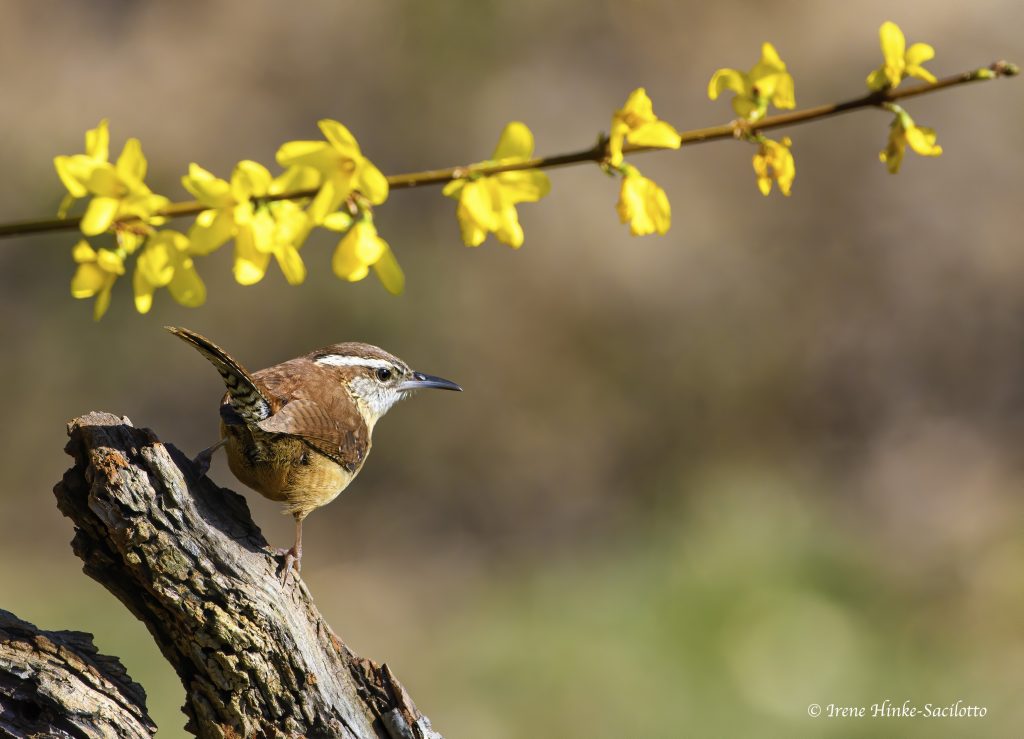
Carolina Wren photographed in local park attracted by feeder.
But I could not change conditions and was not financially destitute like many people, so I started to look for ways to turn this situation into a positive opportunity. I had plenty work to do on the computer—organizing and editing images, updating presentations, prepare advertising, producing a newsletter, etc. But I needed to be outside photographing at least part of the time. With no backyard where I could photograph, I decided to look for photo opportunities in my neighborhood. I checked out a number of trails and parks searching for non-crowded places with urban wildlife. Although some areas had limited possibilities, I did discover two gems.

Red-bellied Woodpecker landing on tree trunk.

Male Red-Bellied Woodpecker spotted when I heard it.
Initial Project:
At one park there was an osprey nest where I spent some time and I got the image above. Another park, five minutes from home, offered a number of opportunities to photograph squirrels, groundhogs, ospreys and an assortment of other birds. I created a feeder station in an open field near a line of shrubs. I baited the scene with birdseed, peanuts, suet and peanut butter. I added small evergreen branches and blooms from nearby trees for a natural looking environment. Squirrels and a variety of birds such as cardinals, wrens, sparrows, and grackles visited the site. Unfortunately, my setup disappeared when park maintenance workers unexpectedly cut the grass in the field. In addition, when the “Stay at Home Order” was issued, the park became a popular place to exercise. Many visitors came with huge bags of peanuts and bird seed which they liberally spread along the trails, attracting the resident squirrels for entertainment. With food everywhere, nothing came to my feeders. So, I had to find another location for photography.

Osprey with fish often head before seen.
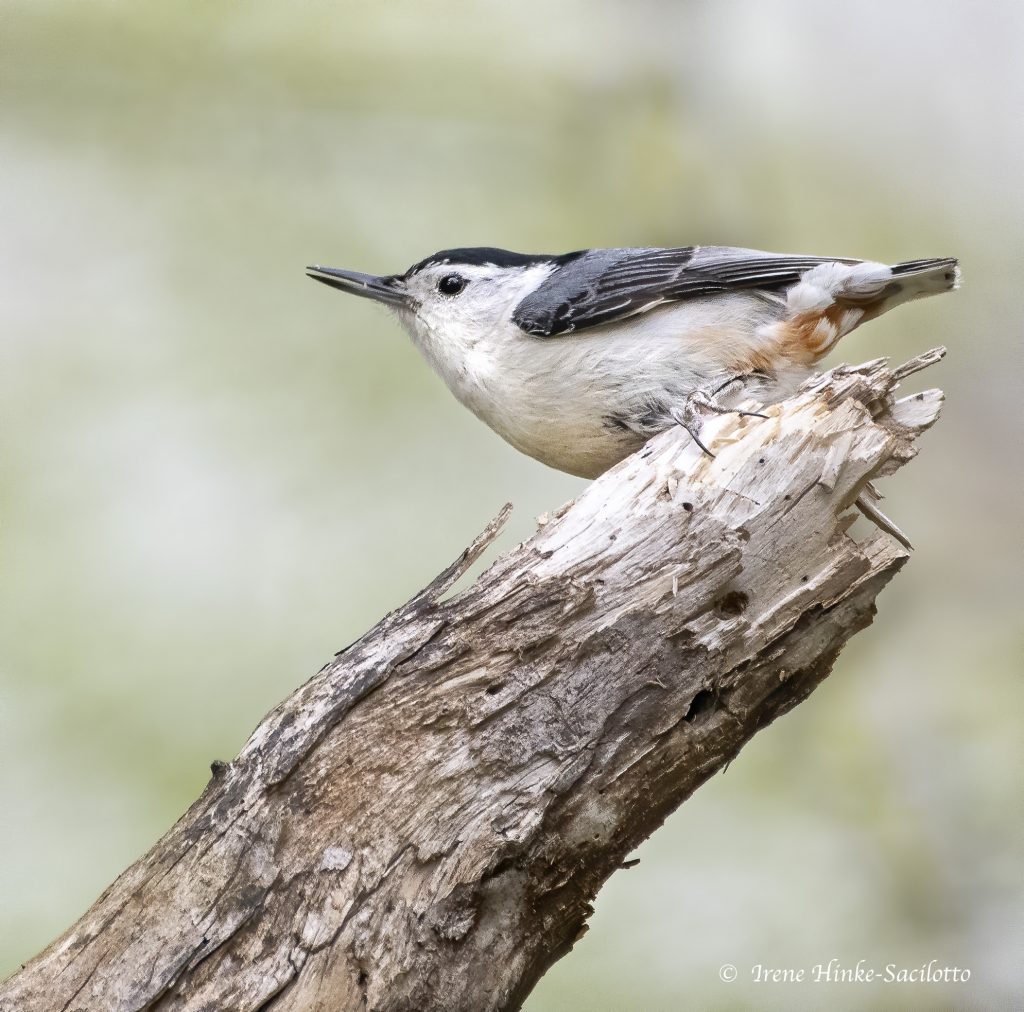
Nuthatch on branch in park.
2nd Project
Elsewhere in the park, I located a large old tree stump. It was adjacent to a path and as people passed by, they tossed peanuts and seeds on it attracting squirrels and also a variety of birds –chickadees, titmice, wrens, doves, blue jays, nuthatches, and red-bellied woodpeckers. To the scene, I added perches for the birds and some extra bird seed. I set up my tripod and camera just off of the path and was able to photograph a number of bird species. But more people kept coming to the park, making photography here more difficult.

Young Gray Squirrels in tree cavity.
3rd Project
While I was taking my daily walk for exercise, I discovered a tree cavity that was home to a family of young gray squirrels. I placed my tripod just off the path and for several days photograph the activity at the hole until the young squirrels outgrew their living quarters and left.

Young Gray Squirrel in tree cavity stretching.
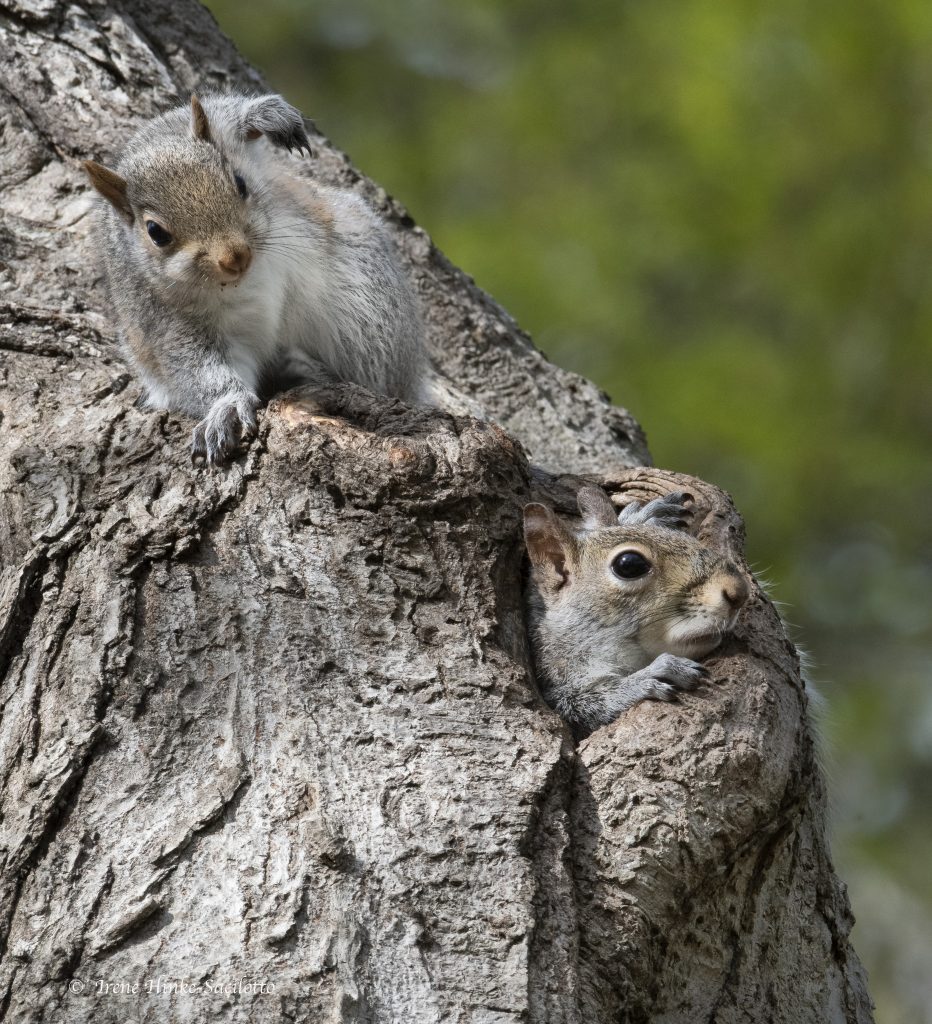
Young Gray Squirrels in cavity.
4th & Continuing Project
During the spring, I had reconnected with old friends. One living nearby owed several acres of land with an open field, a vegetable and flower garden, and woods. She is an animal lover and already had bird feeders at two locations in her yard. Better yet, on occasions, she saw foxes, groundhogs, and racoons from her porch. She was kind enough to allow me to photograph at her home and set up a blind. She loved seeing the resulting images. The experiences photographing at her house during June and July, and August will be covered in my next newsletter.

Pair of Black-capped Chickadees

by Osprey Photo Workshops & Tours | Oct 7, 2020 | Bird behavior, Bird photography, MD, Nature, Nature Photography, Photo instruction, Photo Technique, Photo Workshops, Uncategorized, Wildlife, Wildlife Photography
Urban Wildlife Photo Project
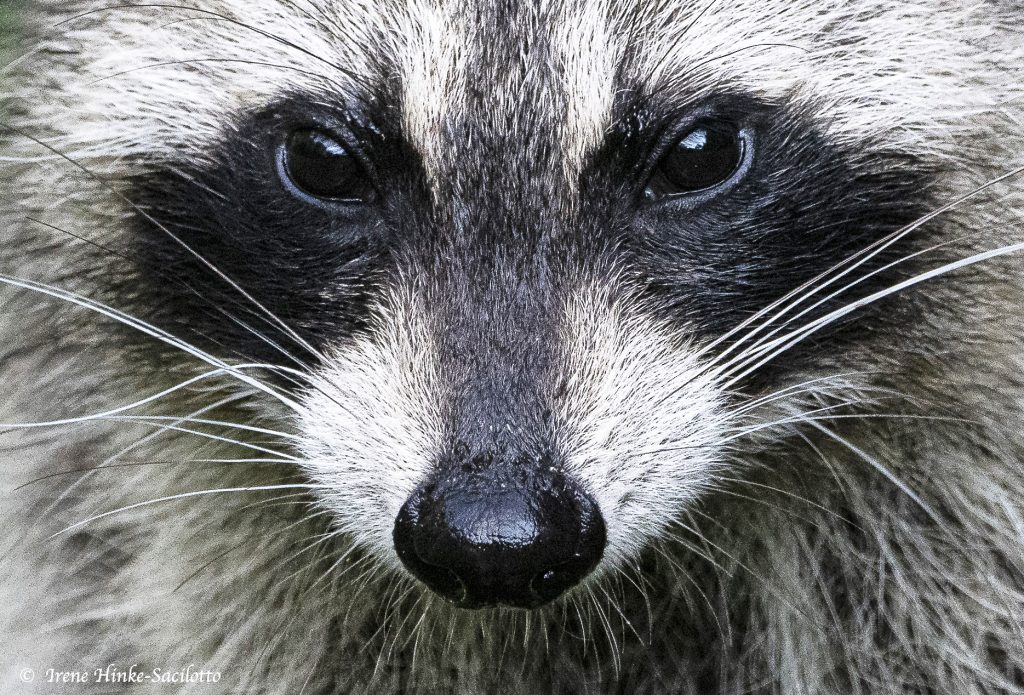
Raccoon Eyes
Overview
As mentioned in my last newsletter, in recent months I have reconnected with an old friend who has been allowing me to photograph on her property. She lives nearby and owns several acres of land with an open area, vegetable garden, flower beds, woods, and a pond by the house with aquatic plants, dragon flies and frogs. She has two permanent bird feeder locations that are near bushes and tall trees. One is located at the far end of the yard with the other near her house. Bushes and tall trees were nearby both. They provide cover from which the animals could safely approach the feeders as well as escape if threatened by hawks, foxes, or other predators. When the weather allowed from late April until today, I would spend several hours early in the morning or late in the afternoon photographing in her yard. In July when, temperatures soared into the mid to high 90s and humidity rose feeder activity slowed and was limited to the cooler times of the day and after sunset. The drop in activity seemed to continue into September.
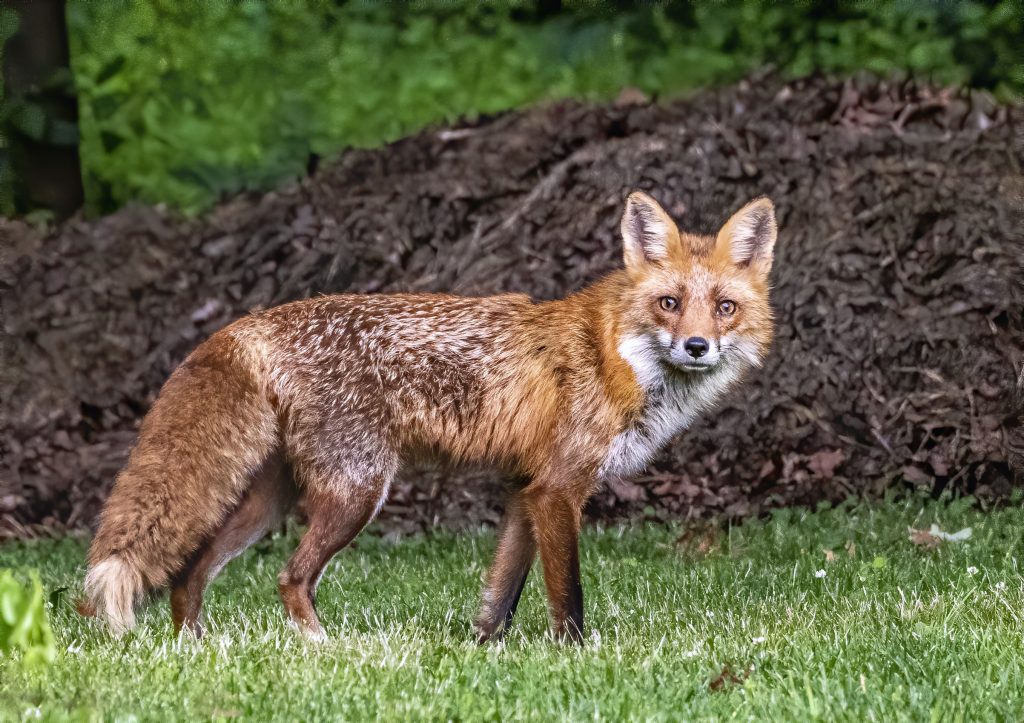
Red Fox emerging from woods.
Initial setup
In late April, I began photographing at the bird feeder nearest the house. It was close enough that I could photograph from my friend’s dining room window. In addition to standard bird seed and suet feeders, we hung a thistle sock on a branch to attract gold and purple finches. The non-melt suet, that could withstand the summer heat, attracted the small woodpeckers, chickadees, and nuthatches. At times we added meal worms to the mix, which seemed to be a favorite of the Carolina Wrens. The bird feeder at this location was elaborate with arms and multiple hooks from which to hang a variety of feeders. I added a few natural perches for the birds to land on, but to my disappointment, they seemed to prefer sitting on the iron appendages of the feeder stand. After several days shooting, I concluded that the way the sunlight hit the area was not ideal for it cast unwanted shadows on the birds. In addition, the bushes behind the feeders were very close making it difficult to blur the background even with the lens wide open and a shallow depth of field. It became even more distracting when hit by bright sunlight.

Raccoon eating apple put out to attract deer.
Second location
Adaptability, perseverance, and patience are all keys to successfully photographing animal behavior. When I failed to get satisfactory results at my first location, I shifted my attention to activity around the permanent feeder at the far end of the yard. Nearby, there was a bird bath and kiddy pool filled with water to attract wildlife on hot dry days. Since I did not want to photograph the birds at the feeder, I created what I have affectionately call my animal jungle jim. With logs, tree roots, branches, other items that I collected roadside and from nearby woods, I created a setup where I hung additional feeders and provided a safe place for the birds to perch. At key locations on the logs, I smeared peanut butter and suet. For the squirrels, raccoons, and jays, I added unsalted, raw peanuts to the wildlife buffet. After watching squirrels for an extended period of time, I am convinced that they are smart and agile and that very few bird feeders are squirrel-proof.

Black-capped Chickadee with the sun breaking through trees behind it.

Post to attract woodpeckers and the birds with suet block nearby.
Urban Wildlife Photo Project (cont.)
Periodically, I changed the arrangement to vary the background in my photos. For variety, I added a vertical 4-foot-long tree trunk cemented in a bucket that I could move to different locations. I baited it with a peanut butter/suet mix and placed a cage filled with suet nearby hoping woodpeckers and other birds would first perch on the trunk before jumping to the feeder. I added a small tree to the mix for birds to perch in, hoping to vary the appearance of my images.
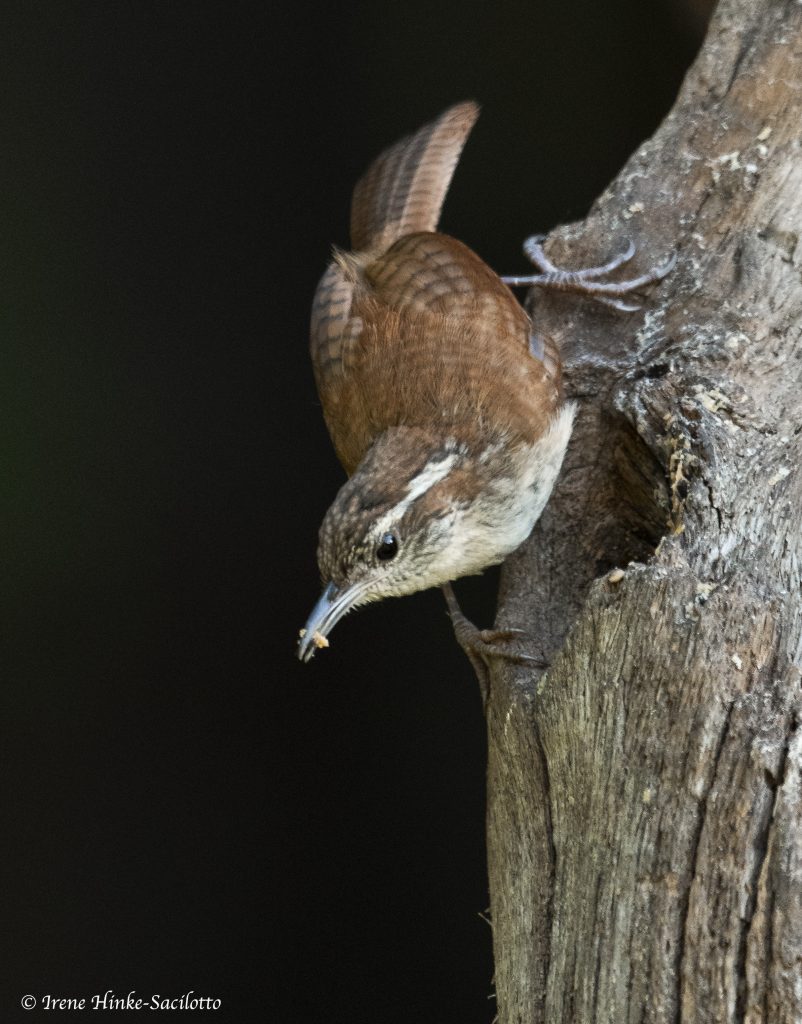
Carolina wren on post.

Downey woodpecker on side of tree trunk.

Frog escaping from backyard pond.
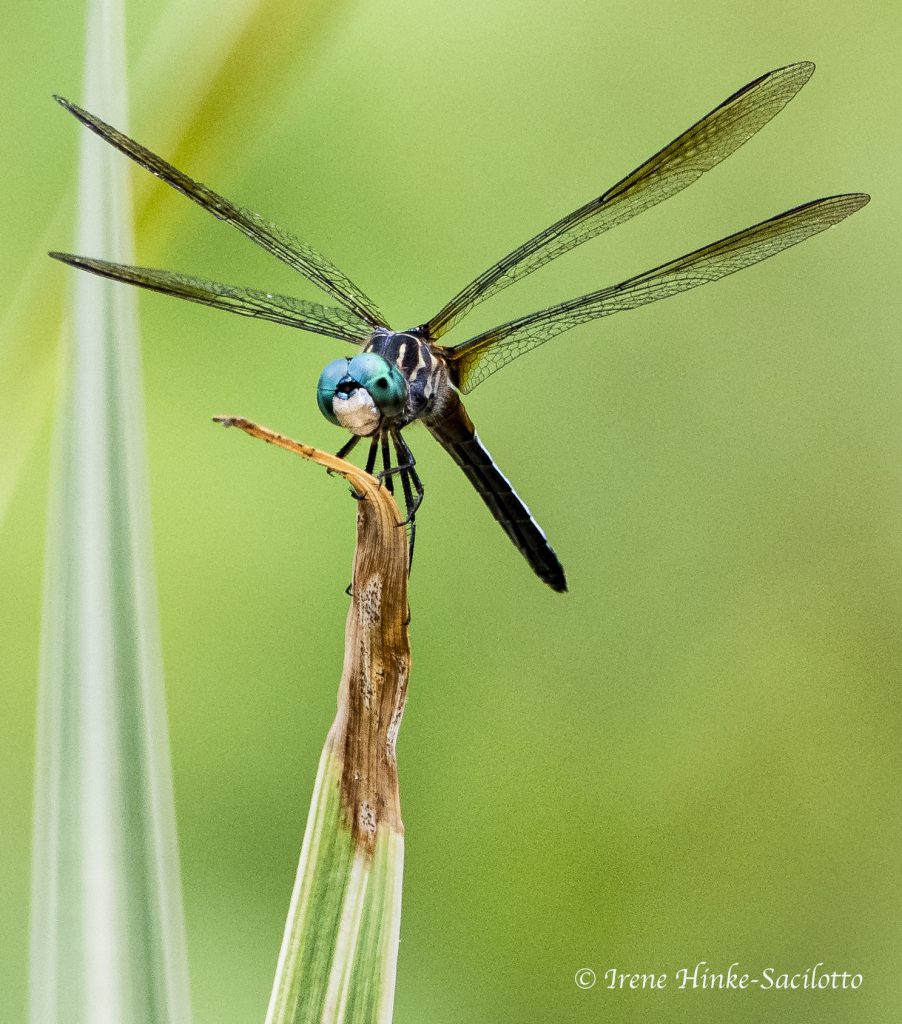
Dragonfly at pond
A couple days when activity at the feeders was low, I switched my attention to smaller subjects, dragonflies and frogs. But I only had my Nikon 200 to 500 mm lens with me instead of my 200 mm macro lens designed for close focusing. When I moved forward towards the subject to increase magnification to what I desired, the autofocus could not lock on it. Remembering a similar situation in the past, I switched to manual focus and discovered I could get closer to the subject and still keep it in focus. For the dragonfly, I had to avoid my shadow falling on it. I took advantage of the fact that if it flew away, it typically returned to the same spot. For the frog photos, I had to be careful to stay low and move slowly. The biggest problem was finding a camera angle where the background was satisfactory.

Gray squirrel peaking around tree trunk.

by Osprey Photo Workshops & Tours | Apr 8, 2017 | Flower Photography, Garden Photography, Longwood Gardens, Nature, Nature Photography, Photo classes, Photo instruction, Photo Technique, Photo Workshops
Photography at Longwood Gardens
in the conservatory
and for similar conditions elsewhere as in a greenhouse
Close-up Photo Tips
Next photo workshop featuring flower photography – 14-15 April at Norfolk Botanical Garden. For info, see my website www.ospreyphoto.com or http://norfolkbotanicalgarden.org To register call (757) 441-5830
Introduction to Photography at Longwood Gardens
A legacy left by Pierre du Pont, Longwood Gardens consists of over 1,077 acres of indoor and outdoor gardens with fountains, reflecting pools, flower beds, woodland trails, and meadows. Located near Kennett Square, Pennsylvania, in the Brandywine Creek Valley.
The 4-acre indoor Conservatory of Longwood Gardens houses plant displays that are varied throughout the year. It is divided into climate-controlled rooms representing various climates and plant species from around the world. My favorite is the orchid room, filled with species from all over the world, varying in color from red to black, with some shaped like lady slippers and others resembling insects. At any time during the year the display showcases 200–300 of the 6,200 orchids housed at Longwood Gardens.

Orchid Arch
Depth of Field (DOF) Issues
The more you magnify your image, the shallower the depth of field in the photo, i.e. the amount of scene that is sharp in front and behind the point of focus (1/3 in front and 2/3 behind). With high magnifications, you can increase the depth of field slightly by selecting a higher f-number (smaller lens openings) but with extreme magnification this may have only have a marginal effect. You may opt to use less magnification to gain depth and then crop the image during editing to exclude the unwanted surroundings.
A shallow depth of field is not necessarily a bad thing and can be helpful to isolate the subject and keep the background from becoming a problem by being well defined. Isolation of the subject in this fashion is particularly effective if the background is at a distance and you are shooting eye-level with the subject. But shallow DOF can be a problem if the subject you wish to photograph has depth and you wish to capture detail front to back.

Orchid – photo focused on internal parts
Flat Surfaces
When photographing patterns on a leaf or a group of multicolored leaves or flowers, you need to have the face of the lens parallel to the surface to have all portions of the scene within the DOF. To photograph from above a pattern created by a group of leaves or flowers, select a section of the scene where the vegetation is of nearly equal height and distance from the lens. A cell phone with built in camera can have an advantage here because it can be more easily positioned at the desired angle over the subject without the constraints of a tripod or the weight of a heavy camera/lens system.

Leaves shot with i-phone
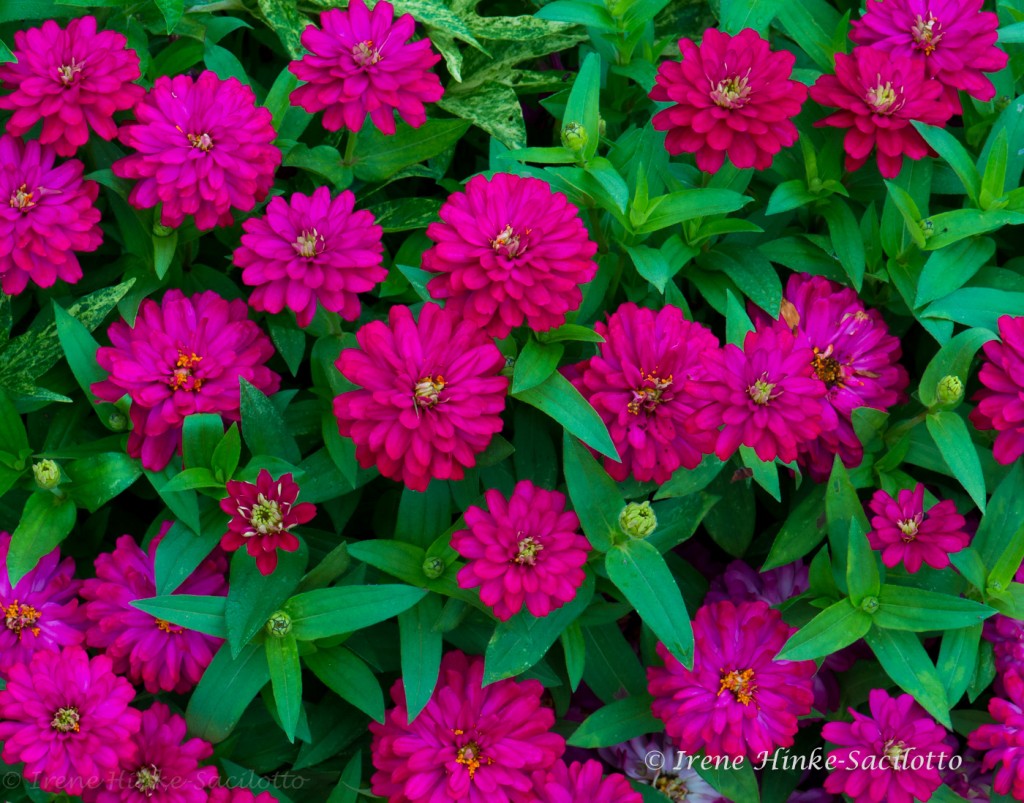
Purple pattern
Manual Focus
Manually focusing your lens allows you to precisely select the part of the scene you wish to be sharp. With some lenses, manual focusing allows you to focus closer to the subject than when using autofocus. This slightly increases the magnification possible with that lens.
Stacking
George Lepp and others have used the technique of stacking to sharply capture each layer of a subject, controlling what is, and is not in focus. This requires taking multiple images of a stationary subject at different but overlapping points of focus and using software such as Helicon Focus. The technique can be used with macro and landscape subjects. For details, see George Lepp’s article in Outdoor Photographer Magazine. http://www.outdoorphotographer.com/tips-techniques/photo-editing-tips/unlimited-depth-of-field/

Orchid Pair
Distracting Backgrounds
It is easy to be caught up with the beauty of a flower or other subject that you ignore obvious distractions in the background. For a photograph to be successful, it is important that the viewer can immediately identify the subject. Anything that directs the eye away from it should be avoided. Such distractions can be particularly troublesome in the conservatory on sunny days. Carefully examine the image in your viewfinder looking for bright or colorful vegetation behind the subject, shiny objects, lights, hot spots from sunlight striking the background, shadows from overhead struts supporting the greenhouse glass, and object appearing to grow out of your subject. If close to your subject, make sure your own shadow is not falling on a portion of it.
Because of the shallow depth of field common with high magnification, you may have a difficult time recognizing distractions behind the subject. One trick to avoid this issue is to temporarily shift the focus of the lens from your subject to the background in search of potential problems – bright areas, shiny objects, strong forms, bright colors, etc. Note possible distractions and then refocus on the subject, keeping these observations in mind. If necessary, move or recompose your image to avoid the offending items.

Jonquil
Visualization
Take the time to visualize your final results. When approaching a subject, always identify what drew you to it initially. Was it its color, abstract patterns, shape, texture, etc. Consider the best lighting and depth of field to emphasize these features. Adjust the f-stop and position the camera accordingly.
Light
Low light can be an issue in the conservatory in areas heavily shaded or on overcast days. High ISO settings on your camera may be required so select your camera that has the best response under these conditions. With many cameras, ISOs higher than 400 are accompanied by noise that reduces image quality and appears as random specs of color and/or something similar to film grain. In your shooting menu, you may have special settings to improve performance at high ISOs or when using slow shutter speeds. Turn them on but don’t forget to turn them off when conditions change. Avoid under exposure since noise becomes more evident as you lighten the exposure. Noise is the most noticeable in dark areas of the image and if the image is underexposed. Editing programs such as Adobe’s Lightroom and software plug-ins provided by Nik and Topaz can help reduce the appearance of noise without compromising image sharpness.
Playback Display Options
In your playback menu on your camera select display options that help you recognize exposure problems. Turn on the histogram and highlight indicator that shows where the image is overexposed and detail lost.
Wires and Sticks
Plants on display are often supported by wires or sticks, so try to avoid capturing them in the photo. This may require changing your shooting angle or magnifying the subject to better isolate the most interesting aspects of the plant. Consider using an editing program such as Adobe’s Lightroom, Photoshop Elements or Photoshop CC to remove the offending object using clone or healing brush tools. In the Lightroom program, you can also use the adjustment brush to lighten or darken areas, open up shadows, and control contrast, sharpness, saturation, etc. The spot removal tool can be used to cover problem areas.
Have fun. The orchid image below was oversaturated intensionally during editing for a bazar artistic effect. I struggled to keep a window sill out of the photo so I avoided it by filling the frame with the subject.

Orchid – High Saturation
Spot-lighting
If the subject is in the sun or is back-lit and background is busy, search for an shadowed area that can be positioned in the frame behind the subject. If no natural shadow is present, have a friend cast a shadow over the offending area or create one of your own.
Polarizer Filter
Mounting a polarizer on your lens can remove reflections from the surface of leaves, water, windows, and make the sky appear bluer. To use one, rotate the outer ring until you remove the offending glare. However, they remove a component of light resulting in slower shutter speeds for the same f-stop, There are warming polarizers that some people prefer to reduce the blue in the image.

Orchids part of Orchid Arch
Lenses
There are applications for any lens from wide angle to telephoto in the garden; however, for flowers close-ups, macro lenses are the most versatile. They are designed for high magnification and are extremely sharp edge to edge with low image distortion. Compared to a standard lens, they able to focus on subjects at a closer distance and thereby magnify the image. Many can reach a magnification of 1:1without accessories. They come in different focal lengths with the 105 or 200 mm lenses being my favorite. The shorter lens has vibration reduction and is easier to handhold but I prefer to use a tripod for stability when possible. The longer focal length lens has a narrower angle of view making it easier to alter the background with slight shift in position. They also offer a greater working distance from the subject. This helps prevent your shadow falling across the subject. Also with live subjects, the greater working distance increases the chance that the subject will not be alarmed and not flee. With a dangerous subject, the extra room provides a safety zone. My 200 mm Nikon Micro-Nikkor lens comes with an adjustable collar around the lens so you can mount the lens on a tripod directly, providing better balance and stability. The collar (see image below) also allows you to easily rotate the camera orientation from horizontal to vertical or in between without having to adjust the tripod or detach the camera from the tripod. The down side to macro lenses is that they are more expensive than standard lenses.
Macro-Zoom lenses have the ability to focus closer to the subject than a standard lens but often they do not have the magnification power of a “true” macro lens and the image quality is often not as good. But they do offer a lot of versatility from one lens.
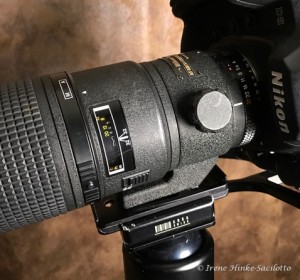
Colar for 200 mm macro lens
Extension Tubes & Close-up Filters
As an alternative for close-up photography, consider purchasing a less expensive set of hollow extension tubes (see image below) that fit between the lens and camera body and allow you to focus closer to your subject than with the lens alone and thereby increase magnification. With no glass involved, the images obtained are quite sharp. Another low-cost alternative is using close-up filters that mount on the front of your primary lens. The resulting images are not as sharp as with the other options but are suitable for aesthetically pleasing images. A tele-converter can also be useful when you cannot get very close to your subject. They increase the magnification of your primary lens without changing your position.

Extension Tubes
Movement Issues:
When using high magnification, movement of the subject or camera is exaggerated and can be detrimental to image quality particularly when using slow shutter speeds. Tripods and monopods help you steady the camera. They are allowed in the garden most of the year but their use is limited in the conservatory. You must obtain a permit to carry it at the info desk near the main entrance to the gardens (Some conditions apply for use, so see Longwood’s web site for guidance). Tripods are not permitted during times of high visitation, particularly during the Christmas season. They can only be used in the conservatory until noon and cannot be used in the Children’s garden. Be considerate of other visitors since the narrow paths can become quite crowed as the day progresses and for popular exhibits.

Hybrid Lilly
More on Tripods
Tripods are useful for more than serving as a stable platform for the camera. With the camera supported on a tripod, it is easier to carefully examine the image in the viewfinder and on the LCD screen for issues related to composition, image sharpness, or background distractions. In the playback mode, consider using your camera’s magnifier for more critical view of image sharpness and depth of field. I frequently use a Hoodman or similar loupe over the LCD when reviewing images in the field. It excludes external light so you can more accurately judge what was captured.
It is wise to invest in a good tripod suited to your needs. Those with legs made with strong carbon fiber are lighter and easier to transport. If you have the opportunity, take your heaviest camera and lens to a pro camera shop such as Service Photo in Baltimore and test various tripods with your set-up. Using an unsteady, cumbersome tripod can be worse than using none at all. I recommend using a ball head mounted directly on the tripod for most applications.
At times, using a tripod can stifle creativity. Often you mount the camera on the tripod, walk around the subject a little, plant the tripod in one spot, and never move it again. Try exploring camera angles without the camera mounted on a tripod. Once you have decided on the best approach, they add the tripod for support.

Orange Stamens
Unwelcomed air movement
Be sensitive to subject movement caused by environmental conditions. The conservatory’s fans, that help regulate climate conditions in each room, circulate air and create drafts that can cause leaves and flowers to move during exposure. Similarly the movement of people passing nearby or opening a door can also generate an unwanted breeze. Be aware of the potential problem and wait for a lull in the motion before taking your photo. To maintain a still camera when taking a photo, use an electronic cable release.
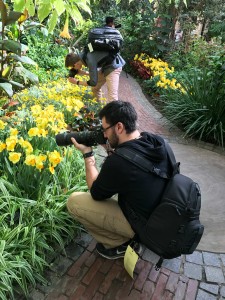
Mark & Adam
More Than Just Flowers
Flowers are photographically intriguing but don’t ignore the garden’s water features, the conservatory’s architecture, and aspects of the plants other than the blooms (the leaves, buds, seeds pods, vines, fruit, etc.). Since the conservatory is quite large, I suggest deciding on specific goals for your visit, perhaps specific rooms, flowers, or techniques. Have fun and experiment with unusual camera angles, abstracts designs, or special effects created by intentional camera movement. Visit local gardens, your own backyard, a nearby meadow, or even a florist shop to improve your skills and creativity.

Tile in Children’s Garden

Umbrellas Suspended from Ceiling

Art Deco Decor in Ballroom of Conservatory

by Osprey Photo Workshops & Tours | Jun 6, 2015 | Bird behavior, Bird photography, Digital Photography, Nature Photography, Photo classes, Photo instruction, Photo Technique, Photo Workshops

Rudy Turnstone.
Value of Patience when photographing wildlife.
The key to good wildlife photography is patience. During my photo workshop on Assateague Island, I observed two ruddy turnstones at Ferry Landing. Class participants took several fine photos capturing interaction between the two. Since I don’t typically photogrpah with the class, I could not resist returning to the same area on the following day in hopes of having similar success. That morning I spent several hours photographing ruddy turnstones, willets, and least sandpipers until canoers arrived interested in launching their boats from the shore. My patience resulted in several great shots including one showing the turnstone flipping shells in search of food, another feeding on eggs, one bathing, another stretching its wings, etc. If you want to capture action, you must watch and wait. If lucky, you will be able to capture behavior that you can not see with your eye. Of course you need fast shutter speeds for this. That is where fast lenses and cameras that perform well at high ISOs give you an advantage, With careful observation, you may be able to predict what is coming next which makes your images more unique. This sense of satisfaction is part of the reward for pursuing wildlife photography.

RuddyTurnstone

Ruddy Turnstone

Ruddy Turnstone bathing.

ruddy turnstone

by Osprey Photo Workshops & Tours | May 8, 2015 | Digital Photography, Flower Photography, FlowerPhotography, Nature Photography, Photo Technique, Photo Tours, Photo Workshops

CREATIVE APPROACH to GARDEN PHOTOGRAPHY
@ Norfolk Botanical Garden, VA
12-14 June 2015
Designed for those who wish to advance their photographic skills, creating images that are more imaginative, distinctive, and visually exciting. Classroom discussions include subject selection, equipment, camera settings, composition, lighting, spatial relationships, and utilization of graphic elements. Includes PowerPoint program, class discussions, and image critiques. Class assignments will encourage creativity and reinforce concepts discussed during the workshop. Includes field practice at the Norfolk Botanical Gardens, in the Tropical Display Greenhouse, outside gardens, and butterfly house. Roses, azalea, camellia, magnolia, dogwood, and other spring flowers should be in bloom. Mirror Lake and other reflecting pools and ponds should provide opportunities to capture images of frogs, turtles, wading birds, waterfowl, dragonflies, and colorful reflections. Includes sunrise photography on Sunday over Lake Whitehurst. To register contact Norfolk Botanical Garden Education Department, http://norfolkbotanicalgarden.org/events/the-joy-of-garden-photography-2/































































